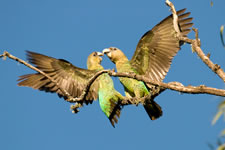Parrot in the Amathole and Transkei regions of the Eastern Cape, South Africa
Cape Parrots (Poicephalus robustus) are endemic to South Africa and Critically Endangered by habitat loss, illegal capture, and avian diseases (e.g. Psittacine Beak and Feather Disease (PBFD)). Based on 12 years of annual counts coordinated throughout their range, Cape Parrots now number between 1000 and 1500 individuals, over 800 of which occur in the Amathole and Transkei regions.

In KwaZulu-Natal, Cape Parrots are recognised as dietary specialists dependent on Podocarpus seed kernels in Afromontane mixed Podocarpus mistbelt forest patches. Similarly, Cape Parrots are also recognised as nest-tree specialists in KwaZulu-Natal, utilising Podocarpus snags (i.e. standing dead trees) almost exclusively for nesting. Cape Parrots are reported to have a bimodal flight activity pattern, whereby they embark on medium- to long-range foraging flights from roosts and nest cavities in high-altitude Afromontane forest patches to feeding sites in low-lying or coastal forests. Historical records and preliminary findings from this study challenge conclusions drawn by studies in KwaZulu-Natal, whereby in the Eastern Cape trophic niche breadth appears to be much wider and nest tree preferences more generalist. Therefore, we propose the ecological and natural history research components of this project. Over 36 months, our study will gather high-quality empirical data on fruiting phenology and food resource abundance in Afromontane forest patches and nutritional value of food resources in the forest canopy, for correlation with the most in-depth study of the feeding ecology and breeding biology of Cape Parrots ever undertaken. We aim to capture more than100 Cape Parrots to take blood for disease testing, screening body condition, and DNA-archiving (for illegal trade prosecutions and taxonomy). Captured parrots will be individually-marked and photographed for identification in subsequent sightings, recaptures and nest observations. Up to 40 Cape Parrots will be mounted with radio telemetry backpacks, and subsequently tracked both from the ground and from the air. Low-altitude, high-resolution aerial photographs and 72 forest transects in targeted forest patches will be used to develop rapid, aerial, forest assessment techniques to monitor the impacts of climate change and human disturbance. Nest boxes, playback of vocalisations, and supplementary feeding will be tested as conservation tools.
In November 2008, we began receiving reports and photographs of Cape Parrots with advanced symptoms of PBFD infection, and thus have focused our current research on the dynamics that support this disease.
This project is being carried out by Postdoctoral Fellow, Dr Steve Boyes together with Professor Phil Hockey. Should you wish to find out more about the project, please contact Steve Boyes at rs.boyes@uct.ac.za.
Image: Photo of Cape Parrots taken by Steve Boyes.
